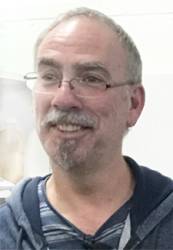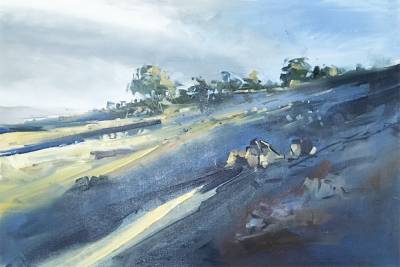Saturday 25th August 2018, 2.00pm to 4.00pm, Ben Winspear Demonstration: Oils, Landscape
 Ben Winspear spent his youth in Harcourt, central Victoria,
famous as apple country. He has a strong emotional attachment to
that area and can paint it from memory. He loves plein air
painting. Today he took a hillside scene as the light fades
throwing long deep shadows down from a hilltop silhouette of
trees. He would use oils rather than acrylics or watercolour as
their buttery feel allows more exploration of the possibilities of
the experience. He has had considerable success with this medium
winning an Alice Bail travelling scholarship to Florence, and
Artist of the Year at Vic Arts Society. After 17 years of painting
he is teaching at Vic Arts alongside Julian Bruere with whom he
teams to take country workshops. He is a cheerful, affable
personality, competent in his trade and confident in handling a
crowd. The front row gave him a challenge with queries and
suggestions but he always had a humorous comeback, even offering
the brush to one of them to show him how to do her suggestion.
Ben Winspear spent his youth in Harcourt, central Victoria,
famous as apple country. He has a strong emotional attachment to
that area and can paint it from memory. He loves plein air
painting. Today he took a hillside scene as the light fades
throwing long deep shadows down from a hilltop silhouette of
trees. He would use oils rather than acrylics or watercolour as
their buttery feel allows more exploration of the possibilities of
the experience. He has had considerable success with this medium
winning an Alice Bail travelling scholarship to Florence, and
Artist of the Year at Vic Arts Society. After 17 years of painting
he is teaching at Vic Arts alongside Julian Bruere with whom he
teams to take country workshops. He is a cheerful, affable
personality, competent in his trade and confident in handling a
crowd. The front row gave him a challenge with queries and
suggestions but he always had a humorous comeback, even offering
the brush to one of them to show him how to do her suggestion.
His preferred support material is linen, sized and taped to a board. Box Frames are bulky and may self-destruct. Linen is light and easy to store. He uses Liquol as a medium as it is fast drying. But remember to wash your brushes or they will be hard next day. A boiling water wash will restore the point on splayed bristles. If the linen is too thirsty rub it over with Liquol first.
He advocated good quality oil paints. It is false economy to buy cheap paints as they don’t last and change colour. You can’t get good work out of crap materials (true of w/c paper too). He gave hints about saving oil paint on a tile under water. To use it drain it off and break the skin. He said that black is underrated; he does not have any store bought greens; don’t have lots of tubes; a blue, a red a yellow, black and white are the basics. But good quality is essential.
Starting off he aimed to cover the linen completely as quickly as possible. He worked with paper towel in hand and just one brush. A quick wipe to change colour. There was a stack of sheets. The picture emerged as a series of dark shadows on a hillside. Ultramarine plus burnt sienna plus black. He showed grassy areas with Prussian blue plus deep yellow plus alizarin for a dark Australian green. There were rock formations in the middle and a silhouette of trees on the high horizon. In the sky clouds arched to join the dark shadow on the hill, a good composition for eye movement. He has quite a dark blue picture at this stage.
Moving to lighter colours with a clean brush and a rag to rub back and to get soft edges, he worked on the rocks and let light in through the foliage of the tree silhouette. If an area didn’t please him he used a palette knife to scrape it right off and start again. You could see why he likes buttery paint.
Afternoon tea came. He was not happy with the central area so he scraped it off and tried again.
 He had plenty of good advice to give. For example,
don’t stroke it to death. Use a minimum of strokes. Try to paint
a lemon in three strokes.
He had plenty of good advice to give. For example,
don’t stroke it to death. Use a minimum of strokes. Try to paint
a lemon in three strokes.
By now he had the broad painting done and took a small brush for the ‘jewellery’, which was a few birds and sheep. Then he stripped off the tape to reveal an excellent painting. He said with a bit of pride, “That is where I come from”.
Colin Browne
Copyright © 2018 Whitehorse Art Society All rights reserved.